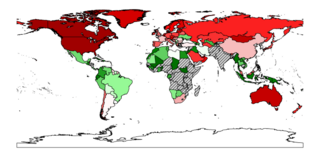Related Research Articles

Environmental science is an interdisciplinary academic field that integrates physics, biology, and geography to the study of the environment, and the solution of environmental problems. Environmental science emerged from the fields of natural history and medicine during the Enlightenment. Today it provides an integrated, quantitative, and interdisciplinary approach to the study of environmental systems.

The ecological footprint is a method promoted by the Global Footprint Network to measure human demand on natural capital, i.e. the quantity of nature it takes to support people or an economy. It tracks this demand through an ecological accounting system. The accounts contrast the biologically productive area people use for their consumption to the biologically productive area available within a region or the world. In short, it is a measure of human impact on the environment.

There is a strong scientific consensus that the Earth is warming and that this warming is mainly caused by human activities. This consensus is supported by various studies of scientists' opinions and by position statements of scientific organizations, many of which explicitly agree with the Intergovernmental Panel on Climate Change (IPCC) synthesis reports.
This glossary of climate change is a list of definitions of terms and concepts relevant to climate change, global warming, and related topics.

A steady-state economy is an economy made up of a constant stock of physical wealth (capital) and a constant population size. In effect, such an economy does not grow in the course of time. The term usually refers to the national economy of a particular country, but it is also applicable to the economic system of a city, a region, or the entire world. Early in the history of economic thought, classical economist Adam Smith of the 18th century developed the concept of a stationary state of an economy: Smith believed that any national economy in the world would sooner or later settle in a final state of stationarity.

Climate change mitigation is action to limit climate change by reducing emissions of greenhouse gases or removing those gases from the atmosphere. The recent rise in global average temperature is mostly caused by emissions from fossil fuels burning. Mitigation can reduce emissions by transitioning to sustainable energy sources, conserving energy, and increasing efficiency. In addition, CO2 can be removed from the atmosphere by enlarging forests, restoring wetlands and using other natural and technical processes, which are grouped together under the term of carbon sequestration.

A carbon footprint is the total greenhouse gas (GHG) emissions caused by an individual, event, organization, service, place or product, expressed as carbon dioxide equivalent (CO2e). Greenhouse gases, including the carbon-containing gases carbon dioxide and methane, can be emitted through the burning of fossil fuels, land clearance, and the production and consumption of food, manufactured goods, materials, wood, roads, buildings, transportation and other services.

Environmental policy is the commitment of an organization or government to the laws, regulations, and other policy mechanisms concerning environmental issues. These issues generally include air and water pollution, waste management, ecosystem management, maintenance of biodiversity, the management of natural resources, wildlife and endangered species. For example, concerning environmental policy, the implementation of an eco-energy-oriented policy at a global level to address the issues of global warming and climate changes could be addressed. Policies concerning energy or regulation of toxic substances including pesticides and many types of industrial waste are part of the topic of environmental policy. This policy can be deliberately taken to influence human activities and thereby prevent undesirable effects on the biophysical environment and natural resources, as well as to make sure that changes in the environment do not have unacceptable effects on humans.

Ecological debt refers to the supposed accumulation of debt of the Global North to Global South countries, due to the net sum of historical environmental injustice, especially through resource exploitation, habitat degradation, and pollution by waste discharge. The concept was coined by Global Southerner non-governmental organizations in the 1990s and its definition has varied over the years, in several attempts of greater specification.
Anthropogenic metabolism, also referred to as metabolism of the anthroposphere, is a term used in industrial ecology, material flow analysis, and waste management to describe the material and energy turnover of human society. It emerges from the application of systems thinking to the industrial and other man-made activities and it is a central concept of sustainable development. In modern societies, the bulk of anthropogenic (man-made) material flows is related to one of the following activities: sanitation, transportation, habitation, and communication, which were "of little metabolic significance in prehistoric times". Global man-made stocks of steel in buildings, infrastructure, and vehicles, for example, amount to about 25 Gigatonnes, a figure that is surpassed only by construction materials such as concrete. Sustainable development is closely linked to the design of a sustainable anthropogenic metabolism, which will entail substantial changes in the energy and material turnover of the different human activities. Anthropogenic metabolism can be seen as synonymous to social or socioeconomic metabolism. It comprises both industrial metabolism and urban metabolism.

In ecology, resilience is the capacity of an ecosystem to respond to a perturbation or disturbance by resisting damage and recovering quickly. Such perturbations and disturbances can include stochastic events such as fires, flooding, windstorms, insect population explosions, and human activities such as deforestation, fracking of the ground for oil extraction, pesticide sprayed in soil, and the introduction of exotic plant or animal species. Disturbances of sufficient magnitude or duration can profoundly affect an ecosystem and may force an ecosystem to reach a threshold beyond which a different regime of processes and structures predominates. When such thresholds are associated with a critical or bifurcation point, these regime shifts may also be referred to as critical transitions.
This is a glossary of environmental science.

Sustainability is a societal goal that relates to the ability of people to safely co-exist on Earth over a long time. Specific definitions of sustainability are difficult to agree on and have varied with literature, context, and time. Sustainability is commonly described as having three dimensions : environmental, economic, and social. Many publications state that the environmental dimension is the most important. For this reason, in everyday use, "sustainability" is often focused on countering major environmental problems, such as climate change, loss of biodiversity, loss of ecosystem services, land degradation, and air and water pollution. The concept of sustainability can be used to guide decisions at the global, national, and individual levels.

The Potsdam Institute for Climate Impact Research is a German government-funded research institute addressing crucial scientific questions in the fields of global change, climate impacts, and sustainable development. Ranked among the top environmental think tanks worldwide, it is one of the leading research institutions and part of a global network of scientific and academic institutions working on questions of global environmental change. It is a member of the Leibniz Association, whose institutions perform research on subjects of high relevance to society.

Planetary boundaries is a concept highlighting human-caused perturbations of Earth systems making them relevant in a way not accommodated by the environmental boundaries separating the three ages within the Holocene epoch. Crossing a planetary boundary comes at the risk of abrupt environmental change. The framework is based on scientific evidence that human actions, especially those of industrialized societies since the Industrial Revolution, have become the main driver of global environmental change. According to the framework, "transgressing one or more planetary boundaries may be deleterious or even catastrophic due to the risk of crossing thresholds that will trigger non-linear, abrupt environmental change within continental-scale to planetary-scale systems."

Climate debt is the debt said to be owed to developing countries by developed countries for the damage caused by their disproportionately large contributions to climate change. Historical global greenhouse gas emissions, largely by developed countries, pose significant threats to developing countries, who are less able to deal with climate change's negative effects. Therefore, some consider developed countries to owe a debt to developing ones for their disproportionate contributions to climate change.
The biocapacity or biological capacity of an ecosystem is an estimate of its production of certain biological materials such as natural resources, and its absorption and filtering of other materials such as carbon dioxide from the atmosphere.
The, United States Environmental Protection Agency (EPA) began regulating greenhouse gases (GHGs) under the Clean Air Act from mobile and stationary sources of air pollution for the first time on January 2, 2011. Standards for mobile sources have been established pursuant to Section 202 of the CAA, and GHGs from stationary sources are currently controlled under the authority of Part C of Title I of the Act. The basis for regulations was upheld in the United States Court of Appeals for the District of Columbia in June 2012.

Sustainability studies is an academic discipline that focuses on the interdisciplinary perspective of the concept of sustainability. Programs include instruction in sustainable development, geography, environmental policies, ethics, ecology, landscape architecture, city and regional planning, economics, natural resources, sociology, and anthropology. Sustainability studies also focuses on the importance of climate change, poverty and development. Many universities across the United States currently offer sustainability studies as a degree program. The main goal of sustainability studies is for students to find ways to develop novel solutions to environmental problems.
Territorialisation of Carbon Governance (ToCG) is a concept used in political geography or environmental policy which is considered to be a new logic of environmental governance. This method creates carbon-relevant citizens who become enrolled in the process of governing the climate. The territorialisation of carbon governance transforms climate change from a global to local issue. It embodies political practices that serve to connect the causes and consequences of global climate change to local communities.
References
- ↑ Mann, Roberta (2007). "Another Day Older and Deeper in Debt: How Tax Incentives Encourage Burning Coal and the Consequences for Global Warming". Pacific McGeorge Global Business & Development Law Journal. 20: 111.
- ↑ Friends of the Earth International. 2000. Greenhouse debt Archived 2008-06-12 at the Wayback Machine . Link (20):
- ↑ Hamilton, Clive. We will all pay for Howard's hidden greenhouse debt Archived 2008-06-05 at the Wayback Machine , Crikey, Friday, 14 December 2007: .